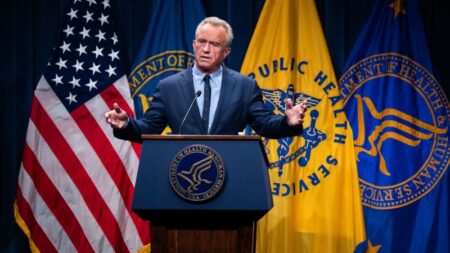In recent developments concerning U.S. health policy, Robert F. Kennedy Jr., in his initial actions as Secretary of the U.S. Department of Health and Human Services (HHS), unveiled new guidance outlining a restricted definition of sex. This guidance, released on a Wednesday, appears to pivot away from scientifically recognized definitions and aligns closely with an executive order signed by former President Donald Trump in January. The implications of this move have raised eyebrows across a spectrum of health professionals, legal experts, and advocacy groups.
The newly established guidelines were accompanied by a website dedicated to these definitions and to promote the HHS’s rationale for prohibiting transgender women from participating in women’s sports. These actions were directly instigated by Trump’s January 20 executive order entitled “Defending Women from Gender Ideology Extremism and Restoring Biological Truth to the Federal Government.” The order mandated that the HHS develop guidance elaborating on the definitions of sex within a tight 30-day timeline.
Critics argue that the latest HHS directives represent a troubling reversion to policies akin to those during the Trump era, which sought to invalidate the identities of individuals who are transgender, nonbinary, or intersex. This approach starkly contrasts the more inclusive health policies and research agendas promoted by the previous Biden administration. The definitions provided in the new documents mirror the narrow language found in Trump’s executive order, covering terms like “male,” “female,” “woman,” “man,” and “boy.” Additionally, HHS has introduced definitions for terms such as “father” and “mother,” underscoring its restrictive viewpoint on familial identities.
Unpacking the definitions reveals slight variances, notably in how HHS defines “male” and “female.” Trump’s order describes a male as a “person belonging, at conception, to the sex that produces the small reproductive cell,” while HHS opts for a definition that focuses on a male’s reproductive capabilities to produce sperm. Moreover, the HHS reiterates Trump’s framing of sex as “a person’s immutable biological classification as either male or female,” conveniently omitting a crucial delineation from the executive order that specified “sex” does not encompass the concept of “gender identity.”
Historically, federal definitions of sex have encompassed broader criteria. For instance, the Centers for Disease Control and Prevention (CDC), a branch of HHS, defined sex as an individual’s biological status that could include a spectrum beyond just male and female, as referenced at birth. Gender was traditionally acknowledged as a separate, interrelated concept that consisted of cultural roles, behaviors, and expectations.
Within the context of these new definitions, many are voicing concern over potential ramifications for healthcare, scientific research, and LGBTQ+ rights. Michele Bratcher Goodwin, an esteemed health law professor at Georgetown University, criticized the definitions as scientifically flawed and highlighted the deeper legal issues posed by the executive order. Bratcher Goodwin asserts that the administration’s stance counteracts established legal standards and scientific findings, calling attention to the long-term consequences for health professionals in how they interact with diverse patient populations.
The gravity of the situation is echoed by Omar Gonzalez, a health law expert from Lambda Legal, who articulated that the guidance fails to recognize the complexity intrinsic to the human experience. He dismissed the HHS’s actions as mere “showmanship,” deeming the linkage to executive orders as a strategic maneuver with minimal genuine implications.
The skepticism towards these definitions extends to further exclusions as well; individuals who identify as intersex, approximately 2% of the U.S. populace, are not acknowledged within either the executive order or the new HHS guidance. This oversight, as emphasized by Bratcher Goodwin, perpetuates the narrative that intersex persons are invisible, further complicating the health landscape where diverse identities are critical for holistic care.
Opponents to these measures have characterized the definitions as insidiously “mean-spirited” and overly reductive. Cait Smith, a director at the Center for American Progress, described the policy language as a regurgitation of anti-transgender legislation, advocating for the rights of LGBTQ+ individuals amidst the tentative legal landscape where federal protections remain intact.
As states grapple with upcoming challenges to such policies, civil rights advocates like Smith emphasize the necessity of empowering educational and medical institutions to comprehend and navigate such murky waters while preparing to challenge unfair policies in courts. Ultimately, the prevailing sentiment among critics and advocacy groups is one of proactive resistance against what they perceive as regressive health policies that foster confusion rather than constructive dialogue. This latest initiative from the HHS and the Trump administration marks an authoritative move that will necessitate continued advocacy and legal scrutiny to ensure that the rights and identities of all individuals, particularly those within the LGBTQ+ spectrum, remain protected.












